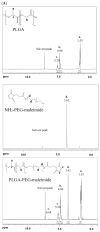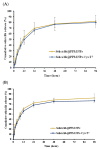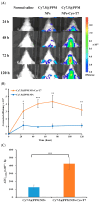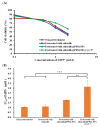Peptide-Engineered Seliciclib Nanomedicine for Brain-Targeted Delivery and Neuroprotection
- PMID: 40565229
- PMCID: PMC12193198
- DOI: 10.3390/ijms26125768
Peptide-Engineered Seliciclib Nanomedicine for Brain-Targeted Delivery and Neuroprotection
Abstract
Seliciclib, a cyclin-dependent kinase 5 (CDK5) inhibitor, has demonstrated neuroprotective potential. However, its therapeutic application is limited by poor permeability across the blood-brain barrier (BBB). In this study, polymeric nanoparticles (NPs) modified with a BBB-targeting peptide ligand (His-Ala-Ile-Tyr-Pro-Arg-His) were employed to encapsulate seliciclib. In vitro transport studies showed that the peptide-modified NPs exhibited significantly greater translocation across a bEnd.3 cell monolayer compared to unmodified NPs. Furthermore, in vivo biodistribution analysis revealed that the brain accumulation of peptide-modified NPs was 3.38-fold higher than that of unmodified NPs. Notably, the peptide-conjugated, seliciclib-loaded NPs demonstrated a significant neuroprotective effect against the neurotoxin 1-methyl-4-phenylpyridinium (MPP⁺) in differentiated SH-SY5Y cells.
Keywords: nanoparticles; neuroprotection; peptide; seliciclib.
Conflict of interest statement
The authors declare no conflicts of interest.
Figures










Similar articles
-
Surface functionalized albumin nanoparticles of palbociclib with amplified brain delivery for treating brain glioblastoma.Sci Rep. 2025 Aug 4;15(1):28433. doi: 10.1038/s41598-025-13721-w. Sci Rep. 2025. PMID: 40760154 Free PMC article.
-
Effectiveness of epigallocatechin gallate nanoparticles on the in-vivo treatment of Alzheimer's disease in a rat/mouse model: a systematic review.Daru. 2024 Jun;32(1):319-337. doi: 10.1007/s40199-023-00494-8. Epub 2023 Dec 11. Daru. 2024. PMID: 38079104 Free PMC article.
-
Breaking Barriers in Glioblastoma Targeting through Advanced Nanoparticle Cell Membrane Coating.ACS Appl Mater Interfaces. 2025 Jun 18;17(24):35288-35303. doi: 10.1021/acsami.5c07306. Epub 2025 Jun 9. ACS Appl Mater Interfaces. 2025. PMID: 40488690 Free PMC article.
-
Biosynthesized nanoparticles of Tibetan medicine mercuric sulfide preparation to promote endocytosis and realize drug crossing through blood brain barrier.J Nanobiotechnology. 2025 Jun 16;23(1):445. doi: 10.1186/s12951-025-03525-5. J Nanobiotechnology. 2025. PMID: 40524151 Free PMC article.
-
Polyester nanoparticles delivering chemotherapeutics: Learning from the past and looking to the future to enhance their clinical impact in tumor therapy.Wiley Interdiscip Rev Nanomed Nanobiotechnol. 2024 Sep-Oct;16(5):e1990. doi: 10.1002/wnan.1990. Wiley Interdiscip Rev Nanomed Nanobiotechnol. 2024. PMID: 39217459 Free PMC article. Review.
References
-
- He F., Qi G., Cai H., Li T., Li M., Zhang Q., Chen J., Ming J., Tian B., Zhang P. Quantitative phosphoproteomic analysis in alpha-synuclein transgenic mice reveals the involvement of aberrant p25/Cdk5 signaling in early-stage Parkinson’s disease. Cell Mol. Neurobiol. 2020;40:897–909. doi: 10.1007/s10571-019-00780-7. - DOI - PMC - PubMed
MeSH terms
Substances
Grants and funding
LinkOut - more resources
Full Text Sources

